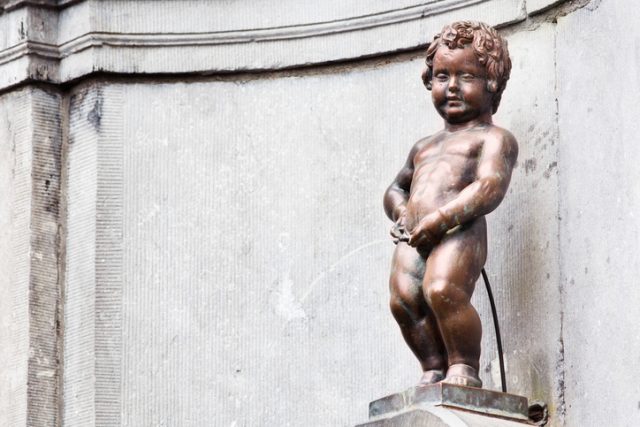The Manneken Pis, translated as”Little man Pee” in Dutch, is one of the most notable and fabulous landmarks one can see in Brussels.
It’s a rather small bronze sculpture capturing a naked little boy urinating into a fountain’s basin. And that’s pretty much it. Nothing more than that, except the facts that there have been at least seven attempts of stealing this sculpture throughout history, and that the little guy has hundreds of different costumes.
The sculpture was originally designed by Hiëronymus Duquesnoy, the Elder and was installed in 1619. Situated at a junction nearby the Grand Place in Brussels, a couple of stories and legends make this small statue so fabulous and famous.
The first one relates to Duke Godfrey III of Leuven, who throughout his career has also been one of the Brussel’s Counts. In 1142, when the Duke was a two-year-old boy, supposedly his troops were battling against the troops of the Berthouts, the lords of Grimbergen. The troops had put the infant Lord in a basket and had the basket hung onto a tree to tease them. Eventually, the boy urinated on the troops of the Berthous, which lost the battle.

Another legend, maybe a more intriguing one, relates to the city of Brussels itself, during the 14-th century. At one point, Brussels was under siege by a foreign power and the city had held its ground for quite some time. The attacker who had the plan to annex the city then placed explosives around the city walls, but a little boy named Julianske saved the day. After seeing the preparations of the enemy, Julianske had urinated on the burning fuse, and with his small act, he has saved the city of Brussels. A similar story tells of a young boy awoken by a fire, and thanks to his urinating, he saved the king’s castle from burning down.
There are two more down-to-Earth stories related to the Manneken Pis statue, referring to a boy who allegedly was missing, only to be found urinating around the city.

The first and very famous one, tells of a wealthy merchant who during his family visit to Brussels, had his young son missing. The merchant then initiated a search party and inspected all corners of the city until the boy was found happily urinating in a small garden. To express his gratitude towards everyone who had helped the search, the merchant built a fountain in the city center.
The other legend tells of another small boy who went missing whilst his mother was shopping downtown. In a total panic, the mother called upon anyone she came across, even the Mayor, to come and help the quest of finding her lost boy. After the search, the little boy was found urinating on the corner of a small street.

The wardrobe of the Manneken Pis is rather generous compared to the majority of anybody else’s wardrobe.
It has several hundred different costumes, hence the little boy, gets dressed in a couple of different costumes through the course of each week. There is even a special schedule for the dress arrangement.

Part of the collection that Manneken Pis is wearing, is also available at a permanent public exhibition at the City Museum in Brussels. It is the non-profit association, “The Friends of Manneken-Pis”, that manages the dressing of the tiny statue, as well as reviews hundreds of new designs which are submitted for it, annually. Only small number of the new designs gets produced and used.
The oldest costume on display in the City Museum dates back to the 17-th century, but the real proliferation of this peculiar custom in the Belgian capital is evident throughout the 20-th century. Oftentimes, the changing of the Manneken Pis costume makes a special ceremony along with a brass band and some live music.

Many of the costumes worn by the Manneken Pis are national dresses which represent other nations, or carefully selected dresses that depict specific professions or branches of the civil and military services. On some days, the statue is hooked up to a keg of beer, hence cups are filled with beer flowing from the statue and given out for free to passersby.

To further intensify the celebrity-like figure of the Manneken Pis, it should also be noted that it has been stolen at least seven times throughout the past centuries. The last attempt was in January 1963, by a group of students from Antwerp, who had the statue hijacked for five days, before handing it over to the Antwerp authorities.
Read another story from us: The Venus of Hohle Fels is the oldest statue depicting a woman’s figure
The incident has stimulated the creation of a replica to take the place of the original version on the site. The original statue is now kept at the Maison du Roi/Boorhuis on the Grand Place in Brussels. Other replicas of the Manneken Pis can be seen in other cities across Belgium. Moreover, the statue is famous beyond the borders of its native country. There is a replica even in countries as distant as Japan.
